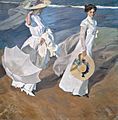Luminism (Impressionism) facts for kids
Luminism is a special style of painting that came after Impressionism. Artists who painted in this style paid a lot of attention to how light looked in their pictures. They wanted to capture the bright, sunny feel or the soft glow of different times of day.
This art style was popular in a few different countries. In Belgium, especially in Flanders, artists like Emile Claus and Théo van Rysselberghe were famous for it. Many other painters followed their lead, including Adriaan Jozef Heymans, Anna Boch, Évariste Carpentier, Guillaume Van Strydonck, Leon de Smet, Jenny Montigny, Anna De Weert, George Morren, Modest Huys, Georges Buysse, Marcel Jefferys, Yvonne Serruys and Juliette Wytsman.
After Emile Claus passed away in 1930, his student, Anna de Weert, kept painting in the Luminist style. She worked from her studio near the city of Ghent.
Contents
Luminism in Different Countries
Luminism wasn't just in Belgium. Artists in other places also used this style, but sometimes in their own unique ways.
Dutch Luminism
In the Netherlands, some painters used Luminism in their early work. These artists included Jan Toorop, Leo Gestel, Jan Sluijters, and even Piet Mondriaan. Their style was sometimes called early pointillism, which is when artists use tiny dots of color to create a picture.
Dutch Luminism often used large areas of bright color. This made it look a bit like another art style called fauvism, which is known for its bold and strong colors.
Spanish Luminism
In Spain, especially in the Valencian region, a group of important painters also used a style called Luminism. The most famous artist in this group was Joaquín Sorolla. Other artists included Ignacio Pinazo Camarlench, Teodoro Andreu, Francisco Benítez Mellado and Vicente Castell.
The Spanish Luminists were very good at showing the bright sunlight and clear skies of their country. Their paintings often show scenes from the beach or everyday life, full of light.
How Luminism Differs
Even though different groups of artists used the name "Luminism," their styles could be quite different.
Emile Claus's work, for example, was very similar to the famous French Impressionists, like Claude Monet. These artists focused on capturing the changing light and colors of nature.
On the other hand, Dutch Luminism used bigger patches of color. This made it look more modern and a bit like the Fauvist style, which used very strong and bright colors.
Gallery
-
Paseo a orillas del mar by Joaquín Sorolla, 1909. This painting shows a sunny day at the beach.
See also
 In Spanish: Luminismo para niños
In Spanish: Luminismo para niños














